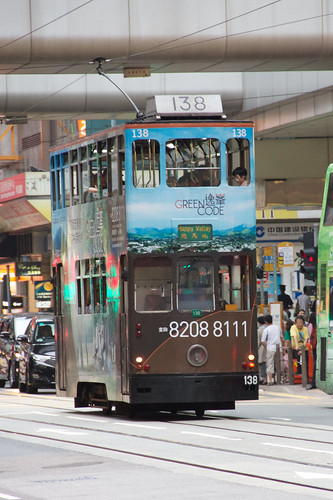Last week the New York Times ran an interesting piece on Hong Kong’s historic street-level trams.
These double-decker, non-air-conditioned relics are apparently quite the workhorses.
According to the Times the trams move 200,000 (220,000 according to Wikipedia) people per day along the 13 km route with 1.5 minute headways between vehicles—and,despite zero government subsidies, they do so profitably.
French company Veolia Transportation owns the trams 100% and is able to eke out a profit from the system, despite fare prices being only approximately $0.30 USD per trip.
All this seems lovely enough, but something just doesn’t add up to me.
How can a privately-run transport system possibly be profitable given these numbers?
Even with ancillary revenues from billboard advertising and “private party” rentals, it is hard for me to understand the economics here.
Let’s assume an average fare price of $0.25—once one factors into the equation pass, child and seniors discounts that number seems reasonable (if not a little bit high). That yields ticket revenue in the $20 million USD range.
Yes, I’m sure that advertising revenue is significant and the cost of drivers in China minimal, but the economics still seem highly dubious.
I’m not saying the system isn’t profitable—it most likely is, or else why would a private company continue to own it? The question I have is how is it profitable?
Any guesses?



5 Comments
With 90% of Hong Kong residents relying solely on public transit, maybe a better question is how can they NOT make money?
http://en.wikipedia.org/wiki/Transport_in_Hong_Kong
PeterK,
That doesn’t really answer the question though. We’re not talking about their transport systems as a whole, we’re talking about one single part of it that is owned privately.
This article may shed some light onto it:
http://www.scmp.com/article/706358/french-firm-completes-takeover-hong-kong-tramways
$30 million profit in 2008 so ~$4 million USD
$10 million in 2007: ~$1.3 million USD
all they are saying is: the profit in 2008 was more than HK$30 million.
that’s around 3,9 million USD.
the other calculation is:
200000 * 0,25 = 5000 USD a day
5000 * 365 = 1825000 USD a year
i guess: first it’s china. so be careful with given statistics.
second: maybe it is integrated in the whole transportation system. like in london – a percentage of the whole travel costs will be paid by other forms of transportation – and believe me: the metro is crowded!
third: if a monthly ticket costs 170 HKD ~ 22 USD, you could make 88 trips on 0,25 USD, to get there. Resulting in almost 3 tickets a day, if you’d go to work 7days a week – which all doesn’t make sense.
So the other way around: to reach HK$30 million you would need 14705 commuters with 12 monthly tickets! Only!
If the tram is used twice by commuters = 14705 * 2 rides = 29410 daily riderships only on commuters.
To reach the total daily ridership of 200000:
170590 more to go with 0.25 USD single tickets on top?
(Yes, in this calculation work days are balanced towards a 7 day week, but I guess it’s just like a drop of water on a hot stone 😉
With 120 stations I believe the daily ridership during peak time could be even higher and don’t forget to add the money for renting a doubledecker tram and maybe sightseeing trams as well.
I hope there you go! 😉
It is not uncommon for public transport agencies to make a profit. even subways make a profit in Singapore,Hong Kong, Kora; Japan etc.
The high poplation density make this systems profitable. Rail transit scales very favourable with masses. A two track system is used anyway jus make the trains and station larger and you can move 50k pphpd.
And dont forget the transit companies make a lot of money from their real estate. The rentals for shops at a busy interchange are just astronomic. So if they manage to run the whole transit just at break even or e small loss, The still will make a nice profit ftom their real estate. Did you notice that no tram in HK runs from end to end. Passangers need to change trams and will pass by one or another shop.